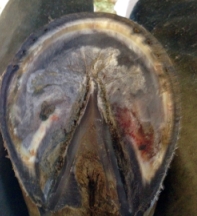When a racehorse is going well, often that horse is racing well enough to ignore what appear to be minor problems. If a horse’s performance is on par, often no changes are made to the shoeing in an attempt to maintain that current level of performance.
In this scenario, a potential problem, deemed to not be threatening, may go unchecked and unchanged. This is how they become bigger problems that eventually do affect performance.
Heel bruising, also known as corns, are definitely one of those culprits in this situation. Horsemen and farriers see this sign of trouble and, realizing that the horse is racing pretty well, make no changes because it is a common ailment that doesn’t always change performance significantly. If this continues over a long time, the budding problem is thought to be something else because the horse was racing very well with the bruises before.
Fig. 1 is such a case. This was an open pacer who dropped in class far enough that cheap conditioned races were being lost. Last quarters in 29 seconds don’t win many races these days and it is one place sore feet manifest themselves very clearly. After seeing the massive size of the bruising, I felt that changes had to be made. To see something like that and not make changes I believe is the epitome of being stuck in a rut and afraid of change. “As long as the horse is doing well, don’t risk it” must be the thinking.
 (Photo by the author) Fig. 1: The foot of an open pacer that turned out to have sore feet.
(Photo by the author) Fig. 1: The foot of an open pacer that turned out to have sore feet.
Bruising like this is the result of subsolar hemorrhaging that migrates to the bottom of the hoof, sometimes weeks after it occurs. The ruptured blood vessels may have actually healed by the time you see it in the insensitive (outer) sole. It usually lies between the bar (the structure running parallel to the frog) and the hoof wall. This area is also known as the seat of the corn, hence the name corns for a bruise in the heel. Even if the hemorrhaging has ceased completely, the evidence one sees in the heels may remain for several shoeings after. This is because the blood seen in the hoof horn tubules does not go away; it must grow out as new hoof regenerates much like the bruised fingernail of a person.
There are many causes of these corns. A primary culprit is shoes that are too short. Shoes left on too long create the same effect as short shoes. Heels fit too tight in an effort to prevent horses from catching a shoe and pulling it while on the track can cause corns. Some types of conformation make it devilishly difficult to prevent corns. Offset knees are one example of this.
The obvious point here is that making no changes will offer no help. So even though the horse is racing very well, little problems need to be addressed. Small changes here can prevent major changes down the road.
 Fig. 2: The horse with the sore feet above was fitted with a full pad and silicone to take pressure off the bruising.
Fig. 2: The horse with the sore feet above was fitted with a full pad and silicone to take pressure off the bruising.
With the horse pictured we made several changes to the front shoeing: We used a larger shoe with a full pad and silicone (Fig. 2), thinned the shoe over the bruised area (to lessen the impact there), trimmed the hoof to ease pressure on the bruised side and produce quicker break-over, and moved the nails forward in the shoe, away from the affected area so as not to restrict heel expansion while loading that hoof.
When a horse is racing poorly, it is easy to get permission for changes. By the time the race meet ended, this horse had won the Open Pace again. When a horse is racing well, it is so easy to ignore a small problem because nobody wants to “change a winner” and I definitely sympathize with that. But the wear and tear of racing gets to them all, sooner or later. I have shod horses that were on long win streaks and know it is coming to an end soon. They just can’t get comfortable from their aches and pains. An experienced farrier can feel that. If that farrier knows the horse well, he will recognize it as a change.
Of course this doesn’t always have to be about the feet, but subtle changes can be meaningful even when the horse is performing up to expectations. Sometimes win streaks are kept alive because changes were made.
Veteran Standardbred farrier Steve Stanley of Lexington, Ky., authors a monthly column for Hoof Beats, the official harness racing publication of the U.S. Trotting Association. The American Farriers Journal Editorial Advisory Board member offers plenty of practical advice that will be of special interest regardless of the type of horses that you work with. Click here to read more from Steve Stanley's Hoof Beats series.








Post a comment
Report Abusive Comment